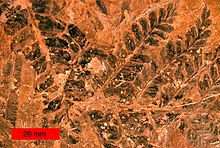Pteridospermatophyta
| Pteridospermatophyta Temporal range: Carboniferous-Cretaceous (Possible Eocene survival) |
|
|---|---|
 |
|
| Fossil seed fern leaves from the Late Carboniferous of northeastern Ohio. | |
| Scientific classification | |
| Kingdom: | Plantae |
| Division: | †Pteridospermatophyta |
| Orders | |
The term Pteridospermatophyta (or "seed ferns" or "Pteridospermatopsida") refers to several distinct groups of extinct seed-bearing plants (spermatophytes). The earliest fossil evidence for plants of this type is the genus Elkinsia of the late Devonian age. They flourished particularly during the Carboniferous and Permian periods. Pteridosperms declined during the Mesozoic Era and had mostly disappeared by the end of the Cretaceous Period, though some pteridosperm-like plants seem to have survived into Eocene times, based on fossil finds in Tasmania.
The concept of pteridosperms goes back to the late 19th century when palaeobotanists came to realise that many Carboniferous fossils resembling fern fronds had anatomical features more reminiscent of the modern-day seed plants, the cycads. In 1899 the German palaeobotanist Henry Potonié coined the term "Cycadofilices" ("cycad-ferns") for such fossils, suggesting that they were a group of non-seed plants intermediate between the ferns and cycads. Shortly afterwards, the British palaeobotanists Frank Oliver and Dukinfield Henry Scott (with the assistance of Oliver's student at the time, Marie Stopes) made the critical discovery that some of these fronds (genus Lyginopteris) were associated with seeds (genus Lagenostoma) that had identical and very distinctive glandular hairs, and concluded that both fronds and seeds belonged to the same plant. Soon, additional evidence came to light suggesting that seeds were also attached to the Carboniferous fern-like fronds Dicksonites,Neuropteris and Aneimites. Initially it was still thought that they were "transitional fossils" intermediate between the ferns and cycads, and especially in the English-speaking world they were referred to as "seed ferns" or "pteridosperms". Today, despite being regarded by most palaeobotanists as only distantly related to ferns, these spurious names have nonetheless established themselves. Nowadays, four orders of Palaeozoic seed plants tend to be referred to as pteridosperms: Lyginopteridales, Medullosales, Callistophytales and Peltaspermales.
...
Wikipedia
